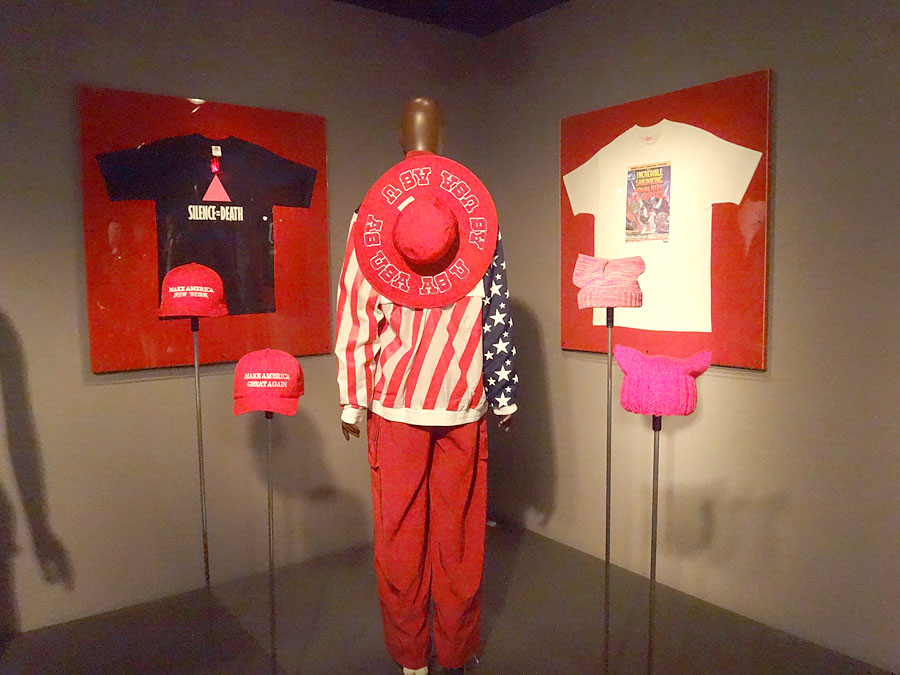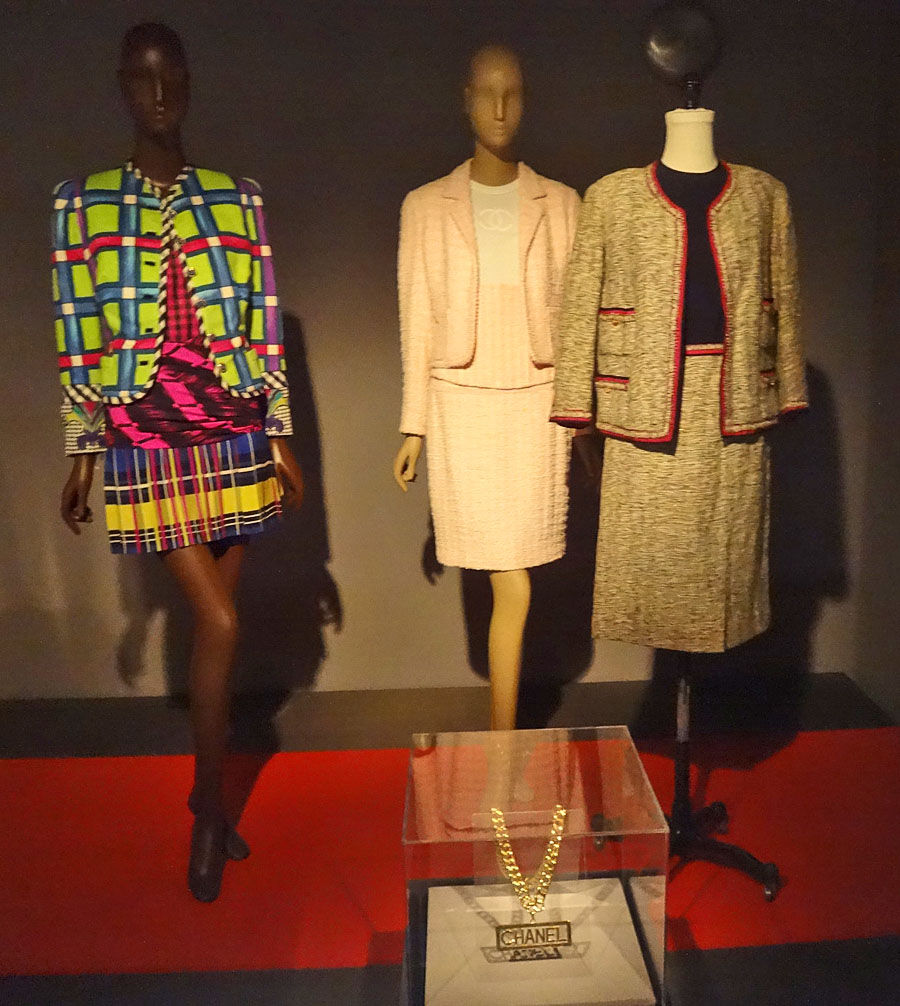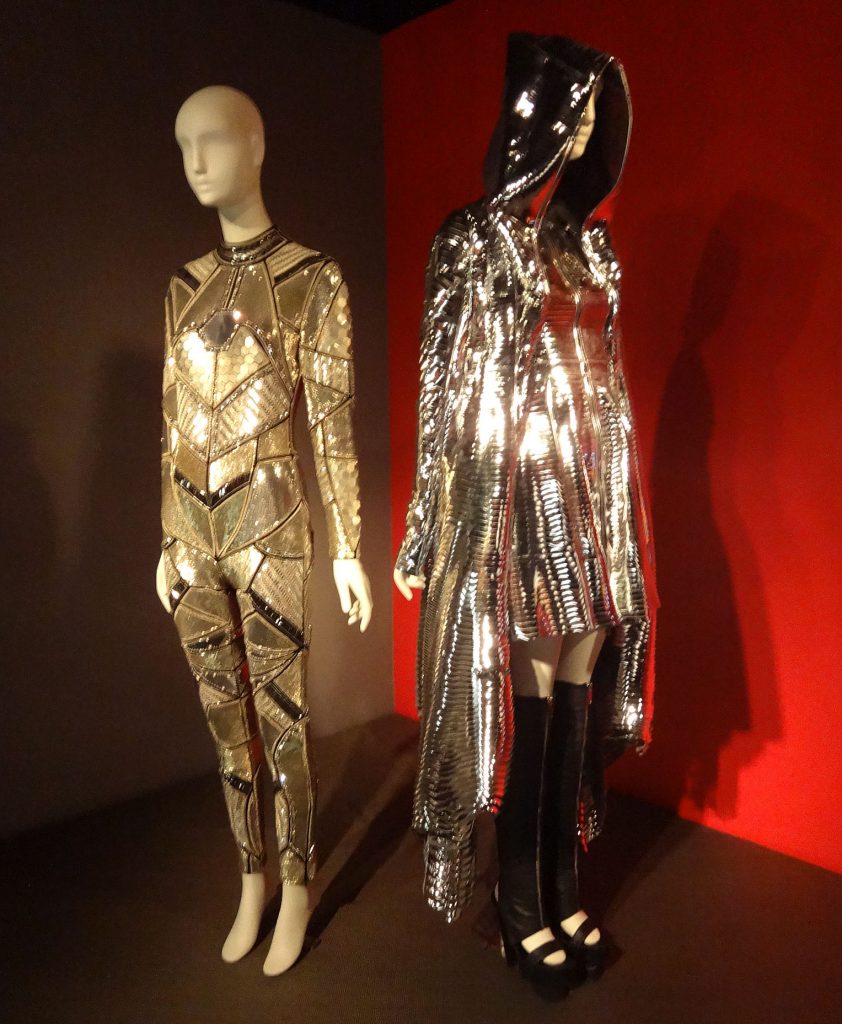
All photos Laurel Marcus
No need to pack your bags to take a power trip to MFIT. “This exhibition is meant to raise more questions than it answers,” said Curator Emma McClendon of the 50 items shown here (through May 9) all from the museum’s permanent collection. “What does the term power really mean? Since the time of Plato and Aristotle, they’ve never come up with a universal definition. Power means different things to different people at different times.”

With the use of five themes (military, status dressing, suiting, resistance dressing, and sex and sexuality), the “five ways that we see power manifested in fashion” are shown. Throughout, there’s a contrast between what McClendon calls the “obvious” versus the more “complex or nuanced” – “what you expect to see and what you don’t” all taken in the broader social context.

Bill Cunningham once said, “Fashion is the armor to survive everyday life.” As a nod to the great master, the exhibition opens with a silver armor-like slashed polyurethane Gareth Pugh dress next to a Philipp Plein spandex, glass, and plastic jumpsuit.

Military uniforms are “coded with the language of power” due to the confluence of tailoring, patches, braiding, stripes, colors, and metalwork making the soldier a walking extension of the state’s power by association. Fashion items are interspersed with actual uniforms: A man’s British Armed Forces c. 1900, a women’s Ralph Lauren recreation of a King’s Royal Rifle Corps jacket (2013), a man’s WWII US army corps uniform and a women’s WWII WAC’s uniform are juxtaposed with a Burberry (Christopher Bailey) short jacket and dress ensemble (2010) featuring green net, green wool, and black leather, as well as a women’s Yves Saint Laurent naval-influenced peacoat (1966).

Status as style is a way to telegraph social position, particularly to display wealth and economic power. From an elegant dress or robe à la française of the late 18th century, wealth could be determined from the voluminous amount of brocade silk jacquard used throughout. The man’s suit features gilded thread while the silk brocade shoes display “gemstones” (often made of paste) but conveying the look of luxe.

Fur also telegraphs status – examples are a late 19th century ermine lined cape and a 1960’s real leopard fur next to a Dolce & Gabbana obvious fake fur.

Logos are another visible display of conspicuous consumption –from the Chanel double C’s to the bold “hip hop” nameplate necklace, from the Gucci loafer horse-bit gold hardware to the Fendi Baguette. Other examples of “logomania” include Jeremy Scott’s Moschino/McDonald’s (Fall 2014) and Demna Gvasalia’s spring 2016 Vetements DHL t-shirt which is a near-exact copy – meant to convey a “biting twist on the branded status dressing of contemporary high fashion” according to the wall text.

The history of the suit is interestingly explored. Although the sharply tailored suit is often considered corporate “power dressing” (the 1980’s big-shouldered suits were worn by men and women alike to convey upward mobility – think “Working Girl” or at the higher-end, Thierry Mugler), suits are also worn by defendants in court. A less tailored, gray denim and linen version was worn by prisoners at Auburn State Prison (1913). The suit can also be a sign of blending in – stripping the wearer of their power and authority. McClendon remarked on the “push-pull of conforming, not standing out” inherent in the suit.

“Fashioning resistance” is also an oxymoronic term of sorts. Is fashion appropriating and commodifying the resistance movement? According to McClendon, designer Kerby Jean-Raymond of Pyer Moss is “using the runway as a social justice reform protest” and “confronting the systemic racism in our culture” while perhaps Maria Grazia Chiuri with her spring 2017 “We Should All Be Feminists” t-shirt is guilty of “commodification.” McClendon believes that resistance clothing became more complicated” due to social media. “Resistance movements are much blurrier than we’ve had in the past,” she added.

Which brings us to fetishwear or “Sheathed in Sex” as the wall text calls it. The Gianni Versace 1992 Bondage collection is often thought of in terms of dominance and submissiveness. Fashion critic Holly Brubach once said of the collection that it “riles women who think this is exploitative and appeals to women who think of his dominatrix look as a great Amazonian statement. It could go either way.” The same is true of ultra-high heels – the feminist critique is that it leaves women powerless — unable to walk or run, while others feel “emboldened with power” when they put on their stilettos.

McClendon’s past exhibitions on denim, uniforms, and body politics all led her to this show. “I got the idea of exploring social constructs through the challenges of each of these projects. I thought about power during this socio-political moment. Pink hats, women in Congress wearing white to emulate the suffragettes — color, slogans, pantsuits– there’s so much conversation. I’m taking stock of where we are now, going into the next election.” This last part was uttered from outside the museum where we were relegated as the fire alarm sounded. Maybe too “hot button” of a topic?
